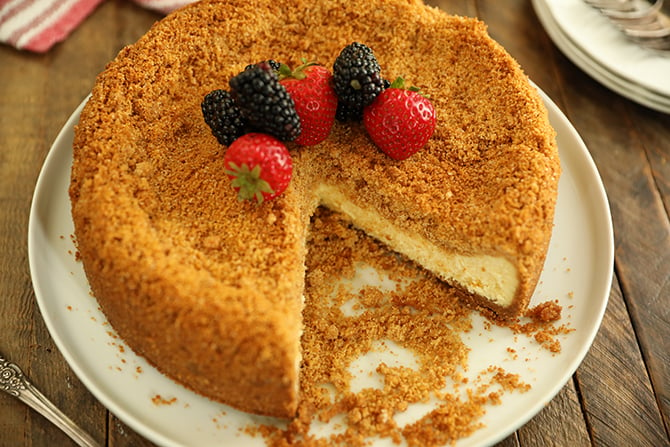 Pin it
Pin it
This double crust cheesecake elevates the classic dessert with a buttery graham cracker crust on the bottom AND top, creating a delightful sandwich of creamy cheesecake between two layers of sweet, crunchy goodness. Perfect for special occasions or whenever you need a show-stopping dessert.
I first made this cheesecake for my daughter's birthday after she requested something "different but familiar." The double crust concept was a spontaneous experiment that has now become our most requested celebration dessert.
- Graham crackers: Entire box creates the perfect amount for both top and bottom crusts with their sweet honey flavor
- Salt: Enhances the graham cracker sweetness and balances the richness
- Sugar: Provides sweetness and helps bind both the crust and filling
- Unsalted butter: Creates that irresistible buttery crust texture and flavor
- Cream cheese: Use full-fat blocks for the creamiest texture and richest flavor
- Eggs: Provide structure and richness to the filling
- Vanilla extract: Adds warmth and depth of flavor to complement the tangy cream cheese
Step-by-Step Instructions
- Prepare the Pan:
- Ensure your springform pan is properly greased to prevent sticking. The light coating of cooking spray will help your beautiful creation release cleanly when serving time comes.
- Make the Crust Mixture:
- Crushing graham crackers to fine crumbs ensures a cohesive crust. Whether using a food processor or the zip-top bag method, aim for uniformity in crumb size. When combining with butter, sugar and salt, mix thoroughly until every crumb is coated in buttery goodness.
- Form the Bottom Crust:
- Use a measuring cup with a flat bottom to firmly press the crumbs into the pan. Work systematically from the center outward for the bottom, then up the sides. Apply firm, even pressure to create a compact crust that will hold together when sliced.
- Create the Filling:
- The key to perfect cheesecake filling is properly softened cream cheese. Leave it out for at least two hours before mixing to avoid lumps. Mix on medium speed only until ingredients are combined—overmixing incorporates too much air which can cause cracks.
- Add the Top Crust:
- Gently distribute the remaining crumb mixture over the filling. Pat down lightly without pressing too hard into the filling. This top layer will become golden and slightly crunchy during baking.
- Bake with Care:
- Watch your cheesecake carefully during the final 15 minutes of baking. The proper jiggle in the center is crucial—too firm means it's overbaked, too loose means it needs more time. The temperature test is your best indicator of perfect doneness.
The graham cracker crust is what makes this recipe truly special. I discovered this double-crust technique when my grandmother shared her secret for keeping cheesecake interesting—"Sometimes the best part of any dessert is the crust, so why not double it?" She would always save a little extra crumb mixture to sprinkle on top of ice cream too.
Perfect Texture Tips
The key to achieving the ideal cheesecake texture lies in the mixing technique. Beat the cream cheese and sugar until just smooth, then incorporate eggs one at a time on low speed. Overmixing introduces air bubbles that can cause cracks during baking. The finished cheesecake should have a silky, dense interior that slices cleanly when properly chilled.
Make-Ahead Instructions
This cheesecake actually improves with time in the refrigerator. Make it up to three days before serving for the best flavor development. The graham cracker crust maintains its texture beautifully over this time, and the filling becomes even more luscious. Simply cover with plastic wrap once completely cooled and store in the refrigerator until ready to serve.
Serving Suggestions
While this cheesecake is magnificent on its own, you can create variations by adding toppings when serving. Fresh berries provide a bright contrast to the rich cheesecake, while a drizzle of caramel or chocolate sauce creates an even more decadent experience. Warm the sauce slightly before drizzling over chilled slices. For a festive touch, dust with powdered sugar or add a dollop of lightly sweetened whipped cream.
Storage Solutions
Leftover cheesecake can be stored in the refrigerator for up to 5 days when covered tightly. For longer storage, freeze individual slices by wrapping each in plastic wrap then aluminum foil. Frozen slices will keep for up to 2 months. Thaw overnight in the refrigerator before serving for the best texture.
Frequently Asked Questions
- → Can I substitute the graham crackers for another type of crust?
Yes, you can use alternatives like crushed cookies, digestive biscuits, or even oatmeal cookies to create the crust.
- → How do I know when the cheesecake is done baking?
The cheesecake is done when the edges are set, but the center is still slightly jiggly. You can also check for an internal temperature of about 145°F.
- → Can I make this cheesecake ahead of time?
Absolutely! This cheesecake needs at least 4 hours to chill in the refrigerator, so making it a day in advance is a great option.
- → What can I use if I don't have a springform pan?
If you don't have a springform pan, you can use a deep dish pie pan, but you'll need to handle slicing carefully to avoid damaging the crust.
- → How should I store the cheesecake?
Store the cheesecake in the refrigerator, covered tightly with plastic wrap or aluminum foil, for up to 5 days. You can also freeze it for longer storage.
- → Can I add toppings to the cheesecake?
Yes! You can add fruit syrups, chocolate sauce, whipped cream, or fresh berries to enhance the flavor and presentation.
